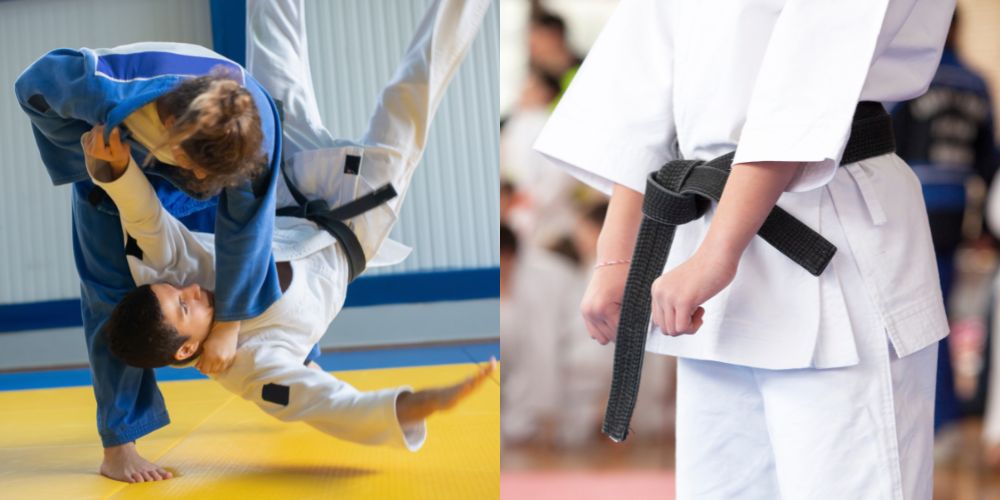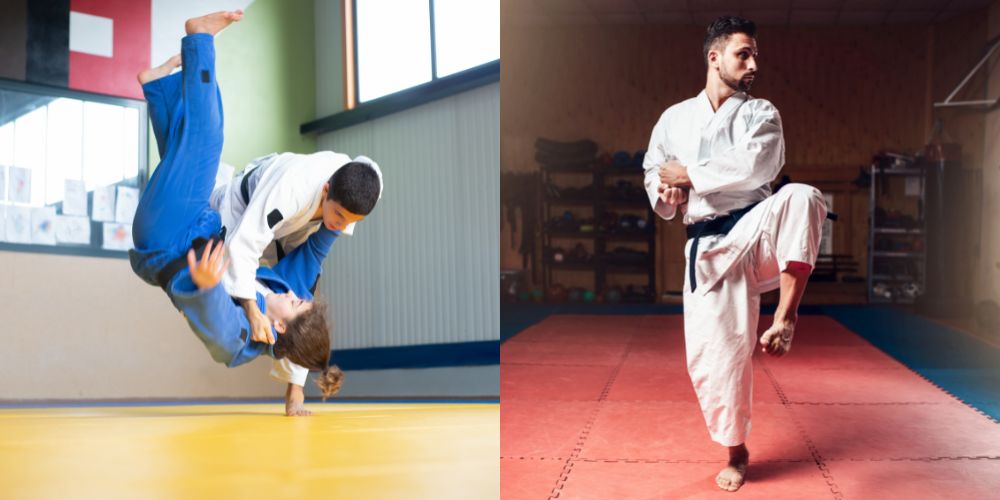Japan is famous for many things, and martial arts are one of its greatest exports. Judo and karate are the two most popular, with only a few other martial arts rivaling them in popularity around the world. But what is the difference between them?
Judo is a grappling martial art with a strong focus on competition and realistic training. Judo is all about balance, throws, and control on the ground. Karate is predominantly a striking martial art with many different stylistic variations, focusing on various techniques and competition rules.
Karate and Judo are on opposite ends of the spectrum of martial arts. Still, their shared homeland makes them more alike than you might imagine. Let’s take a closer look at both and see how they compare.
What Is Judo
Judo is a Japanese martial art derived from jiu-jitsu and is a grappling martial art focused on throwing the opponent, controlling him, or submitting him with joint locks or chokes.
Judo employs a traditional uniform, which is important in the art because it can be grabbed and used to manipulate the opponent. As a result, Judo is the most popular form of wrestling where the jacket can be used, as opposed to western wrestling, where you cannot grab clothing in any way.
Discover The Cutting-Edge Techniques Used By Professional Judo Fighters To Get In Peak Condition
Get this free guide and implement these strength training tips instantly.
Judo was created by Jigoro Kano, who aimed to revive the fading art of jiu-jitsu in a new and more modern form.
Kano stripped jiu-jitsu of its weapons and striking techniques and introduced the principles of “maximum efficiency, minimum effort,” and “mutual welfare and benefit” to the new art known as Judo.
He worked tirelessly to spread his martial art to Japan and the world. His dream became a reality in 1964 when Judo became a part of the Olympic Games. Today, Judo is one of the most popular and widely practiced grappling styles.
What Is Karate
Karate is also a Japanese martial art and was created as a system for self-defense without weapons. The name means “empty hand,” and by design, it encompasses every aspect of unarmed fighting.
Modern karate comes in various styles, some with radically different approaches to combat and various competition rule sets, but striking is always the main focus.
Karate has its roots on the island of Okinawa, where the system was developed under heavy influence from Chinese martial arts and Buddhism.
In the early 20th century, different Okinawan masters started teaching in Japan. Still, the most crucial figure that popularized karate in the country and worldwide was the man who created Shotokan, Gichin Funakoshi.
Today, karate is an umbrella term for all the different martial art styles. Shotokan, also known as sports karate, is the most popular form. It reached its peak after being included in the 2020 Olympics. Fast-paced, light-contact striking battles characterize this style of karate.
The other big branch of karate led by Kyokushin is also known as “knock-down” karate. The focus here is on full-contact fighting and sparring, but without strikes to the head. There are many other styles, each emphasizing specific techniques and competition rules.
Key Differences Between Judo & Karate

Techniques
Karate is a striking martial art; all styles focus mainly on stand-up fighting. Most competition rules include punching and kicking, while some styles also permit elbows and knees.
But outside of competition and sparring, karate takes advantage of the whole body and has strikes with open hands and every other body part practiced in the kihon (basic techniques) and kata (predetermined forms of attacking and defensive sequences).
Judo has three categories of techniques: nage-waza (throwing techniques), katana-Waza (grappling techniques), and atemi-waza (striking techniques). The striking techniques are permitted only in kata and are not used in sparring (randori in Judo).
The strength of Judo lies in the throwing techniques. They follow the structure of unbalancing the opponent and then throwing or sweeping him. The nage waza are further classified by standing and sacrifice techniques, each containing a couple more categories.
For most of Judo’s history, every part of the body was allowed to be used for throws. Still, since 2010, the legs cannot be touched while standing, effectively banning double- and single-leg takedowns.
Judo also has a wide array of submissions, but in competition, only joint locks that attack the elbow and chokes are permitted.
Takedowns
Contrary to popular belief, karate has throws and takedowns in its arsenal. Again, it depends on the type of karate, but Shotokan has a wide array of throws included in its techniques and katas.
Sports karate also allows for takedowns in Kumite (competition), which are very similar to those found in Judo.
In karate, they are also called nage waza. Still, the main difference is that they usually happen during a striking exchange or as an answer to incoming strikes. In Judo, throws result from pure grappling exchanges.
In Judo, a successful throw means an ippon or a sudden victory, but in karate, the throw itself does not score points and must be followed by strikes to be scored.
Other forms of karate also include some grappling. Still, it’s up to the dojo and organization to decide how much of it is implemented in the training process.
Uniform And Ranking
With all the stylistic differences, Judo and karate share an important aspect that many different martial arts have adopted. Both martial arts are practiced in a uniform called a “gi,” derived from the traditional Japanese kimono.
The gi consists of a heavy cotton jacket, loose trousers, and a belt that holds the jacket closed. Judo’s creator, Jigoto Kano, was the one who invented the colored belt system, with each color signifying the rank of the wearer.
The gi used in Judo is thicker and more robust because it is heavily used for grabbing and pulling. Still, the general design of all gi is very similar.
Many other martial arts, both Asian and Western, now use the gi and colored belt systems.
Physical Training
The vastly different fighting styles also demand very different strength profiles in karateka and judokas, with different strength and conditioning routines. Most of all, judokas need elite lower back strength, lower body strength, and explosiveness.
Grip and forearm strength are also crucial, as is maximal strength for certain positions. This means judokas must weight train to develop strength and power if they want to be effective on the mats.
Karate has other demands, mainly in the explosive and reactive strength domains. Punching power and acceleration are well-documented to come from the lower body, so karatekas should focus on intense plyometric and jumping exercises.
Squats and bench presses for maximal strength play a lesser role than they do in Judo, but they still have their place in a karate strength routine.
Judo vs. Karate For MMA

Traditional martial arts don’t have the best MMA reputation. Still, both Judo and karate have produced great mixed martial arts champions.
We must first say that neither is very good on its own and must be modified to fit all the dangers present in the cage. But if applied correctly, karate and Judo provide excellent bases for further development in MMA.
With its lightning-fast linear movement and snappy strikes, karate can catch many fighters off guard. Fighters like Stephen Thompson and Lyoto Machida, who are complete masters, are using their karate skills at the highest levels of MMA. On the other hand,
Judo provides exceptional control in the clinch. Many crafty throws and trips have been used effectively by Ronda Rousey, Satoshi Ishii, Ashihiro Akiyama, and many others.
How Effective Are Judo vs. Karate For Self-Defense
As the famous saying goes, a striker hits you with a fist. A judoka hits you with the earth. Street fights often end up in a clinch or on the ground, which is Judo’s domain. The lack of striking makes it ill-prepared to face vicious punchers.
Still, the ability to control an opponent, incapacitate them, and control where a fight goes makes Judo better for self-defense than karate. It’s not surprising that Judo is taught to law enforcement personnel in Japan and many other places worldwide.
On paper, karate prepares you precisely for self-defense and unarmed fights. But in practice, the style of training and the focus on sports competition leave karate at a disadvantage.
Sports karate does not allow full-contact strikes and stops the action every time a point is scored, which makes it very unreal and even bad for street fights. Still, against an untrained opponent, the reflexes and agility of a karateka may give him the upper hand.
Full-contact karate styles fare much better. Some karate dojos still practice more realistic self-defense techniques and even include some grappling, making them truly practical for self-defense. To summarize, each karate style and each separate dojo has a different level of practical self-defense application.
Karate vs. Judo: Which Is Better For You?
Traditional martial arts have value in places where modern combat sports fall short and vice versa. Judo and karate follow a strict hierarchy, discipline, and tradition.
Both have an underlying philosophy and are meant to be complete systems for improving the human body, mind, and spirit while learning martial skills.
This is what makes them very popular and beneficial, especially for kids and young adults to start with. Both can also serve as a good foundation for later entry into MMA.
The difference comes in the physical aspects. You must first choose if you prefer grappling or striking, which is the most significant difference between the two. As MMA has shown, a complete martial artist needs a bit of both.
Still, there is nothing wrong with focusing exclusively on one or the other. On the physical front, Judo requires more strength and power. Karate requires more agility and speed, so your natural inclination may lean toward one or the other.
Both offer a lifelong road to development for those willing to take it. As an Olympic sport, Judo has more in the way of professional development, money, and competitions.
Most karate styles also have well-developed competition scenes, but not to the level of Judo. It may be challenging to make a living out of karate.
Both martial arts have distinct advantages and disadvantages; only personal preference and goals should guide your choice.

